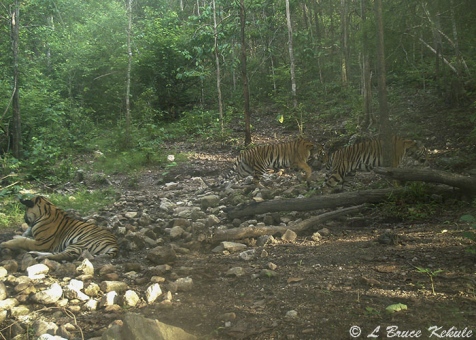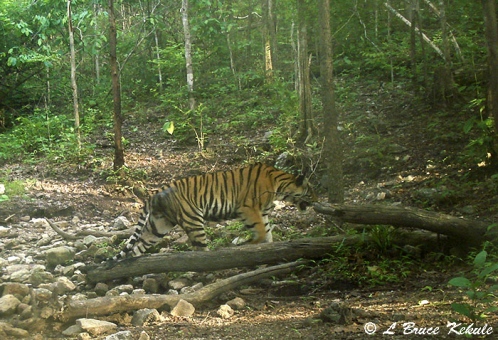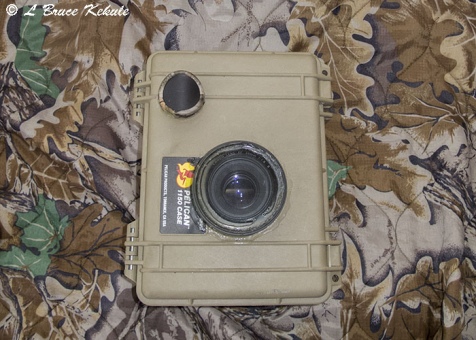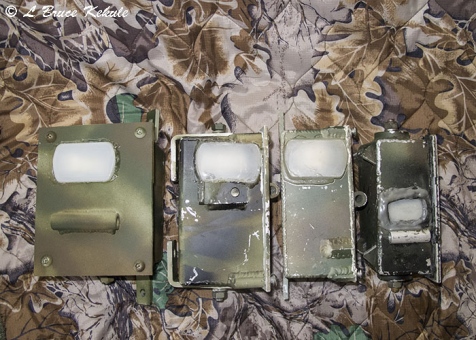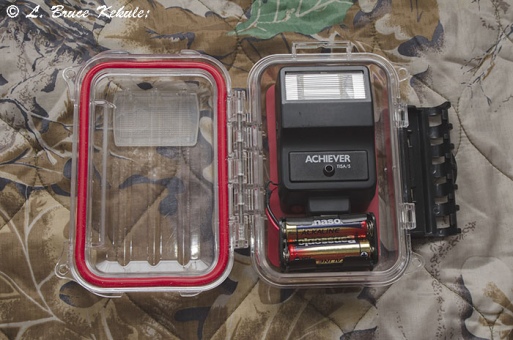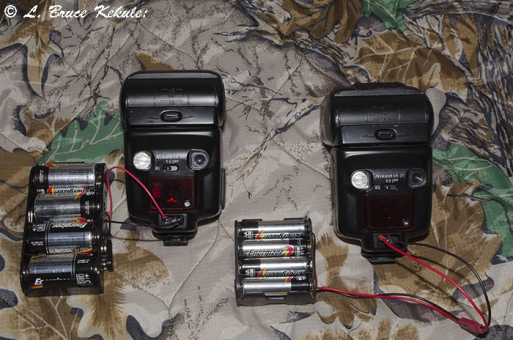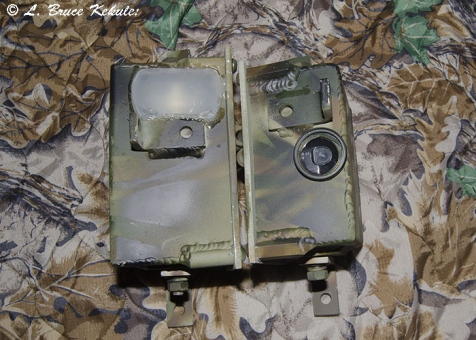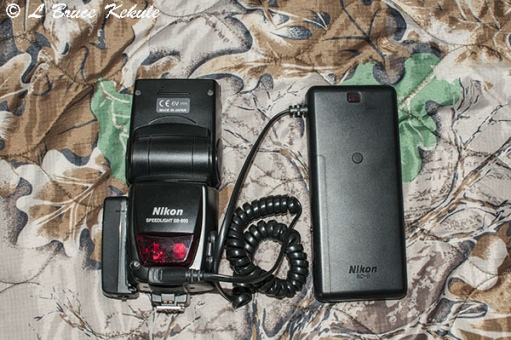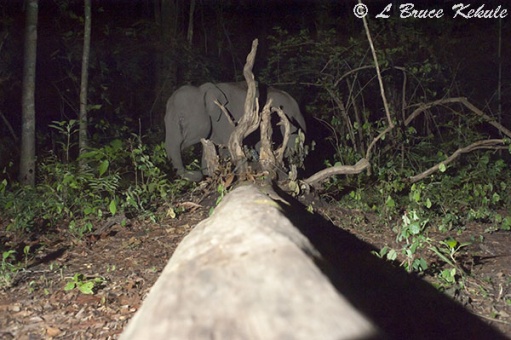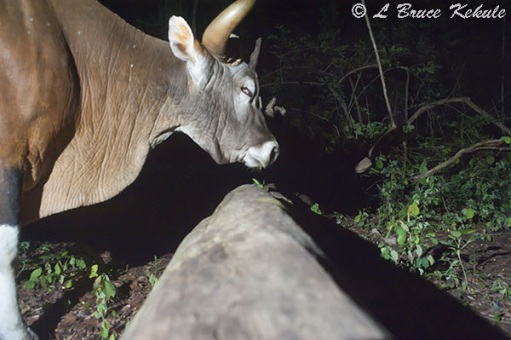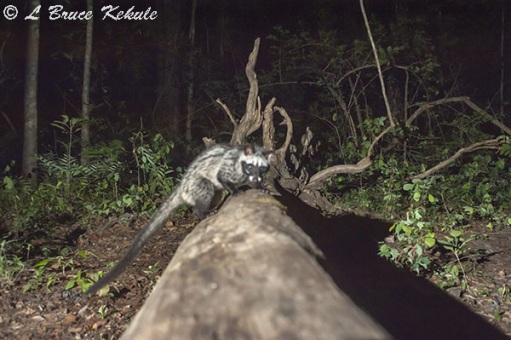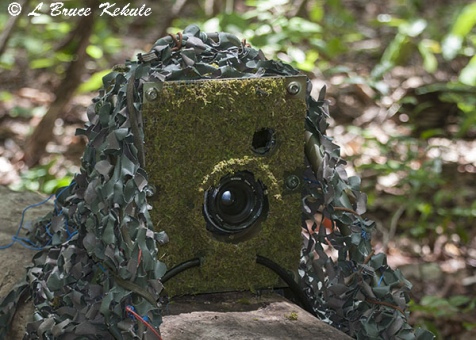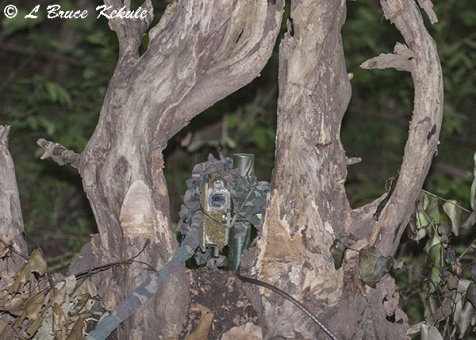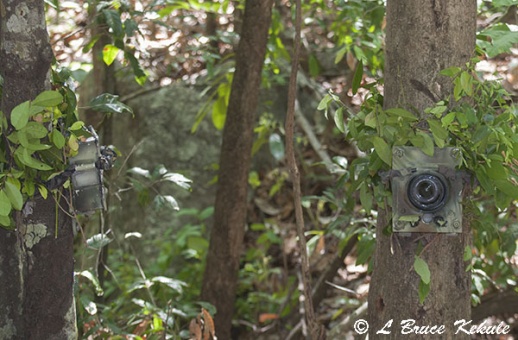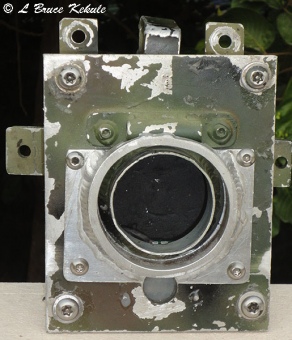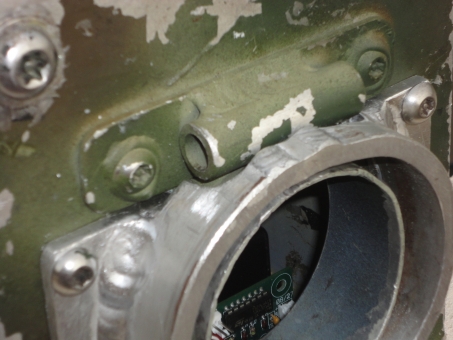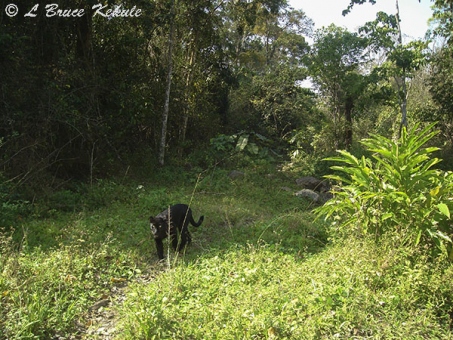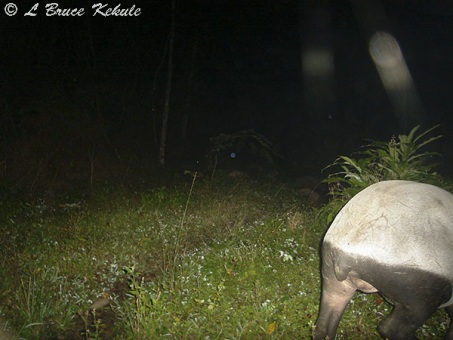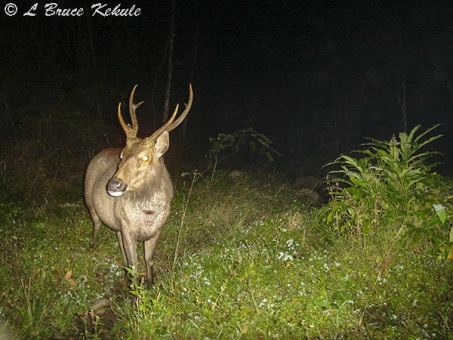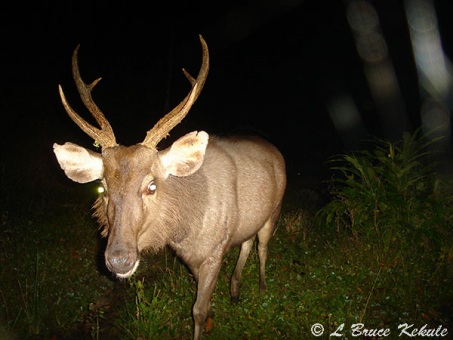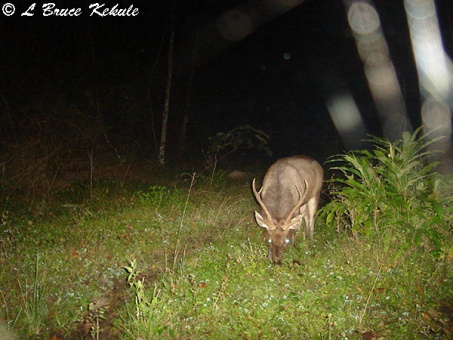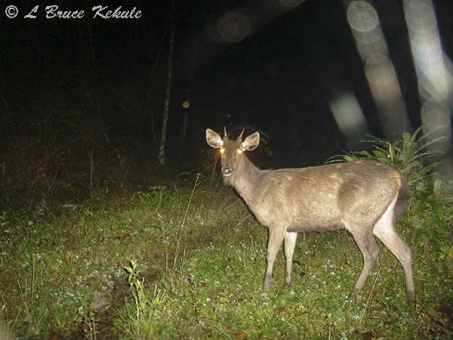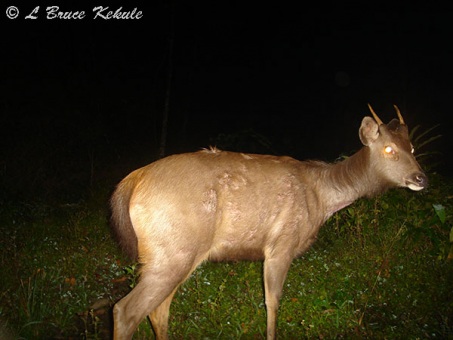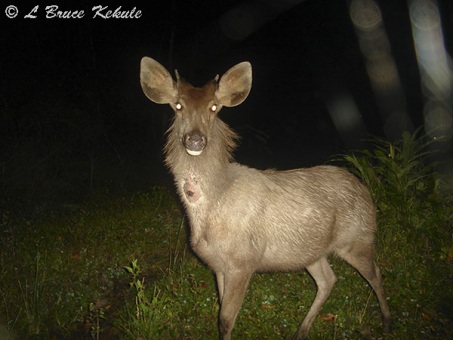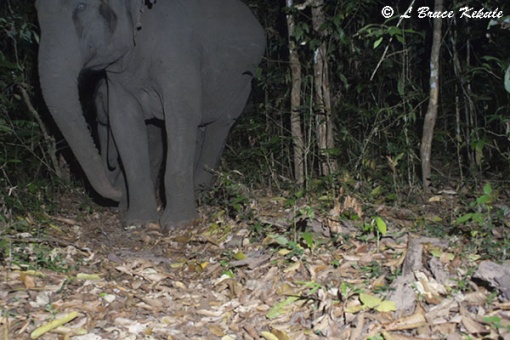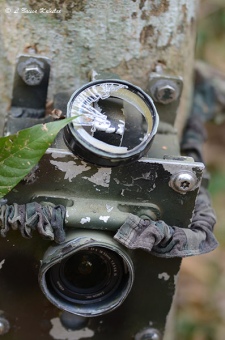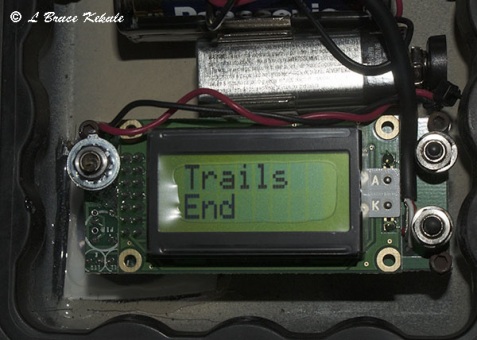Posts Tagged ‘camera-trap’
TIGER AND BANTENG – Sony W30 set
Tiger mother and two full grown cubs.
Recently, I pulled a Sony W30 camera trap from a mineral deposit in the Western Forest Complex and found some amazing photos of a mother tiger and her two cubs. It is very rare to see a tiger family on a trail cam. These amazing creatures usually do not hang around when it starts flashing at them…but I got some great shots shown here.
Mother and cub.
The two cubs leaving the mineral deposit.
Mother on the way out.
Another tiger visits the camera.
Banteng have now become quite rare in Southeast Asia but thrive in two wildlife sanctuaries in Thailand; one in the east and one in the west. Here are some shots of these beautiful wild cattle. The old bull looks like he is having a heck of time with the moths.
Banteng herd at the mineral deposit.
Old banteng bull and moths after a big rain.
A Sony S600 on/off button fix
The single most aggravating thing about Sony S600s is the on-off button. These cams are really one of the best for homebrew trail camera traps and I really enjoy using them. For some reason the switch tends to bottom out and the cam cannot be turned on. I have seen so many where someone previously used their fingernail to turn it on and off, and after awhile it just collapses and will not work.
Sony S600 on-off switch repair
I like to turn my S600s on before deploying in the forest to check the time, date and other things like mode, ISO, flash on, etc, and trying to turn it on with the sensor can be iffy. There is not enough time to check anything before the sensor tells the cam to shut down…!
Solder points for switch repair
All the Sony P and W-series cams usually do not have this problem and even the S40 button is good. As most of my 600s had this problem, I came up with a simple trick to fix this. A small push-button switch and short wire is soldered onto the pad as shown in the photos. Run the wire through the buttonhole and ‘Goop’ in place. I have now fixed all my S600s like this and they are working very well.
Hope this helps those on the forum with this S600 affliction.
A Canon 400D trail cam
A new/old Canon 400D: An easy DSLR in cost and production
Canon 400D with battery grip/Pelican 1150/Snapshot Sniper SSII board/Yongnuo wireless flash trigger plus two ‘D’ cell externals.
Back in march 2012, I built and posted my first DSLR trail cam around a Canon 400D with 18-55mm kit-lens and a Yeticam board (EOS chip) in an old recycled aluminum box I had made up for Minolta 800 si SLR film camera years ago.
I was using Yongnuo wireless flash triggers tripping three Canon 270EX flashes and it was working OK when I left it. Elephants bashed the thin-tube aluminum snorkel breaking the front glass, and then it rained. And that was that…!
Canon 400D in the box.
I then picked up a Canon 350D with the 18-55 kit-lens and got another Yeti board rebuilding the cam. The snorkel was busted again by the forest giants but it did not rain this time and I was able to get it going again with a new replacement glass (77mm UV filter) and an ‘elephant proof’ snorkel protector. This cam is presently working very close to where I camera trapped and was charged by a bull guar.
The 400D in an ‘elephant proof’ box.
I decided to buy a second-hand Canon 400D (Rebel XT-i) body only but this time went with a fixed Canon 50mm ƒ1.8 lens. I picked up a Pelican 1150 box and one of Snapshot Sniper SSII #5 boards and hooked it up with a Canon shutter release (button removed and it has a good 90-degree plug). A 77mm aluminum tube and filter is glued to the case with Goop. A Snapshot Sniper HPWA with a black Fresnel is used with the sniper board.
Canon 400D ready for the field.
The shutter release shielded wire is ground and white is shutter and red is power. The camera is set to ‘Continuous’ and the board to trail mode. I’m getting 5-6 frames per trip and can trip as many as four-five flashes at once. I have several different locations planned for this cam. With a Yongnuo 603C wireless flash trigger with two ‘D’ cell externals and everything fits nicely in the 1150.
Flashes to be used with the Canon 400D.
I have two recycled flashes (a Canon 270EX and a Nikon SB-28) that will make up the group. Another two Nikon SB-26s on ‘stand-by’ mode will also be put into service (one with four ‘C’ cells and one with four ‘D’ cells) to see how long the respective batteries will last. A special modification is made to the SB-26s to allow regular 6-volt 4-cell packs to be used. Another mod is to unhook the ribbon to the monitor after the flash has been set-up (mostly half-power). This will reduce power consumption on the SB-26s.
Nikon SB-26s: one with four ‘C’ cells and one with four ‘D’ cells.
The Canon 400D (300, 350 or 450Ds) are not that big or expensive. There is plenty of room for a pipe through and Python locking cable. It will shoot in ‘Raw’ mode that will allow some latitude in post-processing.
As usual, I have made up an elephant proof aluminum box that will be bolted to a tree with three 3”x 3/8” stainless lag bolts from inside the box plus two 10mm Python cables. The front cover is bolted to the box using six 10mm power-torque machine screws. The flashes are in aluminum boxes with 8mm power-torque machine screws bolted to trees with the same lag bolts and Python locking cables for security.
A Canon 400D with an adapter for Nikon 50mm ƒ1.4 lens.
I have another 400D that will be getting the same treatment except I have an adapter to use an old Nikon 50 ƒ1.4 manual lens. We will see what the difference is in using a plastic lens versus a glass lens. I’ll put my money on the glass out-preforming the plastic…!!
Cost of materials – cost can vary:
Canon 400D………………………………………………….. about $150 (used)
Battery pack grip……………………………………………… about $32 (new)
Canon fixed lens 50ƒ1.8 ……………………………… about $80-90 (used)
Canon Shutter release……………………………………………….. $13 (used)
Pelican 1150 case……………..……………………………………….. $30 (new)
Yonguo 603c flash triggers (a pair)……………………………… $33 (new)
Snapshot Sniper SSII board (#5 chip) & HPWA Fresnel.. $50 (new)
Total cost: about $398 plus labor and essentials (Goop, extra cam battery, drill bits, soldering tools, etc).
Hope this will give some of you camera trappers out there an incentive to build a DSLR…! The cost for some cams is not that expensive and the Canon 400D is a good choice for a first cam.
Nikon D90 DSLR camera trap: Almost a year in the making
A new DSLR camera trap
A Nikon D90 and battery pack with a 50mm ƒ 1.8, SB400 flash and a Yeticam board in a Plano 1460.
Last year in September, I made a post about a Nikon D90 with a 50mm ƒ1.8 lens and a SB-400 flash in conjunction with a Yeticam board in a Plano #1460 clear case.
It was in pieces at the time and sat on my bench until last month when I decided to finish it off. I have two sets but will test this one first to see the results. The SB-400 has four AA externals plus two in the flash for (six). I use either Lithiums or Enelopes.
D90 and an ‘Achiever’ slave flash in a Plano 1499.
The D90, battery pack and SB-400 sits nicely in the case but a relief hole was needed on the side to allow a little more room for the shutter cable. I found some ‘Meike N3’ electronic shutter release for Nikon (90 degree plug) and just cut the button off and attached the wires to a Yeti board. I used a piece of ‘plastic tubing’ and a 10 Baht coin and ‘gooped’ it all in sealing the tube.
D90 in an aluminum ‘elephant proof’ box.
A 3” X 2.8” X 1/8” aluminum tube is used for the snorkel and a 77mm filter is gooped on. No other modifications are made to the case and everything fits perfectly. The Yeticam board is set in the vertical position and an EOS chip was installed.
Achiever slave flash and ‘AA’ externals.
A huge ‘elephant proof’ aluminum box was made up to protect the cam. As this one is really large, I had my welder attach a plate on top at a 45-degree angle to keep the jumbos at bay by not allowing them to get a grip on the top.
Nikon SB-26s with ‘C’ and ‘AA’ externals.
Four 3” X 3/8 stainless lag bolts set the cam tightly on a large tree and I can use two 10mm (3/8”) Python locking cables for extra security.
SB-26s and externals in ‘elephant proof’ boxes.
In the meantime, I added two Nikon SB-26s with 6-volt externals in ‘elephant proof’ aluminum boxes run as slaves. The flashes were modified to take straight 6-volt packs and plugged into the pos. and neg. pins as shown. Real Nikon battery packs cost a fortune. This is an alternative that works very well.
The ‘elephant proof’ boxes were made for the SB-26s that have flash diffusers gooped on the front and 40.5mm UV filters on the back in line with the light sensor.
SB-26s slaves showing diffuser and 40.5mm UV filter.
I also built a small ‘Achiever’ slave flash with 4-AA externals in a clear Plano 1499 case. An old 1020 ‘elephant proof’ box was recycled for this flash. This will be used depending on some locations.
D90 in an ‘elephant proof’ box ready for the field.
I look forward to setting this cam and slaves. I probably will put it close to where I was charged by that bull gaur.
Nikon SB-600/SB-800-900/SB-28 DSLR slave flash
Nikon remote flashes
Nikon SB-600 (middle), SB-800 (left) and SB-28 (right) remote flashes.
After installing and testing my D700 trail cam with several remote SB-28 flashes in the forest, it was apparent I needed another flash closer to the cam on the right side of the fallen tree to eliminate the shadow.
I had an old SB-600 that has been one of my mainstay flashes for some time and since I don’t shoot much flash now, thought I would regulate this one to camera trap duty.
SB-600 and SB-28 with Yongnuo Wireless flash triggers and ‘D’ cell externals.
I will be setting this flash with four brand-new ‘Enelope’ rechargeable batteries to see how long they will last on standby.
A Yongnue 602n wireless flash trigger and two ‘D’ cell externals is used and the assembly is housed in one of my ‘elephant proof’ aluminum boxes. I have now tested the ‘D’ cells and getting more than a month on stand-by…!
‘D’ cells in place.
On this box, I beefed-up the ends and drilled and tapped for 10mm machine screws and set with epoxy to act as pivots, and a ‘L’ bracket on the bottom and a 1” x ¼” x 14” aluminum strap across the top of the log. I can aim the flash straight at the trail and lock it in place. A generic flash diffuser is shortened to about 1/4″ and then ‘Goop’ is applied after camouflage painting.
By using two or three 3” x 3/8” stainless lag bolts, the flash will be tight, and elephants or bears would have hard time breaking these flashes. However, a bear-tooth through the diffuser could be a problem. Of course the proof is in the pudding and we shall see because the big elephant herd will come through one day, and they will surely have a go at destroying the whole set…!
SB-800 with an extra AA battery pack (5 AA cells).
In this box, I can also use a Nikon SB-28 flash that has a great stand-by feature, and is fairly cheap and readily available on the second hand camera market. A SB-800/900 can also be used.
I’m also working on a couple of SB-800s that will have extra Nikon battery packs (5-AAs) set to remote plus the 6-pack. During testing, they work extremely well but are still not TTL. Still working on that. Hope this helps those who need some tough slave flashes for your DSLR trail cam.
SB-800 with Nikon 6-AA battery pack.
Nikon D700 trail cam: The first set
Elephant, banteng, civet and bat captured
Wild elephant; not sure why the cam tripped with the jumbo on the far side of the sensor??
Went into Huai Kha Khaeng to check my D700 trail cam a couple of days ago….the weather was horrible with a big storm brewing and rain had already started to fall. I had to get in and get out.
The young elephant headed for the cam; and it tripped again.
Instead of topping up the card, batteries and desiccant, I decided to pull the unit and two flashes that were not working. One Nikon SB28 flash was still OK and I left it.
A powerful trunk that tried to move the cam but could not budge it.
After downloading the card, I got a pleasant surprise that the D700 had performed quite well on its first stint. Elephant, banteng, a civet plus a bat had tripped the cam.
This elephant ripped most of the camouflage netting off the cam.
There were some strange false triggers but I guess with bats or birds that fly through, the unit will trip to an empty frame. I was elated to say the least.
A mature banteng bull.
I will go back in a week and will move the D700 about two-three feet closer as there is too much log in the frame and the composition is still not right.
This bull looks like he is blind in the right eye.
The elephants ripped most of the camouflage netting off the cam but it survived intact and was still as solid as the log meaning they could not budge it. The moss was OK.
A bat flying through.
Needless to say, I look forward to more sets from this cam. I will be adding another flash to the right side of the log to get rid of the shadow. It is just a matter of time before a tiger or leopard jumps this log.
A common palm civet posing on the log.
Unfortunately, the civet was just inside the focal plane and therefore not in focus. But they are so common here, I’m positive I will get this critter again…! Enjoy.
The Nikon D7oo trail cam on a fallen tree.
Nikon D700 and Canon 350D trail cams on location
Nikon and Canon DSLR trail cams
Nikon D700 camera trap installed on a fallen tree trunk.
Set-up my Nikon D700 and Canon 350D at two locations in Huai Kha Khaeng that are frequented by tigers and leopards, plus many other Asian animals like elephant, gaur, banteng and more. Both cams trigger in continuous mode (three to four shots per actuation).
Nikon D700 camera trap with moss and old leaf camouflage.
The D700 was attached to a fallen tree with six legs bolted down with 3” x 3/8” stainless lag bolts. The transmitter was installed on an aluminum pole pounded into the ground and hidden in the tree roots.
Nikon ML-3 active infrared transmitter in aluminum box.
The Canon 350D was bolted to a standing tree with four lag bolts. Python cables secure both cams and the transmitter to the tree. They are both solid and if an elephant can move the tree, they can move the cams.
Canon 350D and flash installed on a tree next to a wildlife trail.
The Nikon has three flashes set off by ‘YongNuo’ wireless flash triggers with ‘D’ cell externals and three Nikon SB28s. The flashes trigger on the second shot.
Canon 350D beefed-up snorkel.
The Canon has only two flashes (Canon 270EXs) at the moment and this cam triggers them with the ‘YongNuo’ on the second shot too. A third Canon flash is in for repair after some ‘D’ cells leaked and left some residue in the box. I have beefed-up the snorkel as shown here and this should keep the elephants at bay.
Canon 350D beefed-up snorkel – close up.
I’m using four AA ‘Energizer’ Lithium batteries as power in the flashes and we’ll see how long they can last. The next job would be to add externals or ‘flash battery packs’ if the Lithium batteries are not enough for a month’s soak. I’ll be checking the Nikon and the Canon on May 17th and post something after that.
A Black Leopard passes my camera trap
A series of images captured with a Sony S600 camera trap
A black leopard in mid-afternoon on a trail to a hotspring in Huai Kha Khaeng (cropped).
It is now late April in the forest of Huai Kha Khaeng Wildlife Sanctuary, my favorite-place in Thailand. The first rains have come and doused the dangerous forest fires that spread through the sanctuary during the dry hot season starting in March.
Full frame shot of the leopard.
As usual, I’m setting-up camera traps at various mineral deposits (natural seeps) around a ranger station deep in the interior accessible only by a dirt road. These waterholes are visited by all the large mammals including tiger and leopard, and provide excellent opportunities for some great animal shots.
An Asian tapir passes by.
As I was going through a few of my old camera traps changing out cards and batteries, I decided to have a quick look at a 2GB card that was in my Sony S600/SSI/1020, one of my first cams using a Pelican box.
A young ‘tusker’ on the trail showing off.
Imagine my surprise to see a shot of a ‘black leopard’ in mid-afternoon walking on the trail. Other denizens caught include elephant, tapir, sambar, wild pig and muntjac (barking deer) over a month period back in February to early March of this year. The cam recorded some 400 images mostly elephants and sambar. It truly was a bonus and I actually closed out the program with this cam.
Sambar stag on the trail.
I actually forgot to download the card and if I had formatted it, only a recovery program could have got them back as long as I had not filled the card with other images. Been there done that…!
Another sambar stag checking out my cam.
The black leopard brought back fond memories of this place more than 15 years ago. I was sitting in a tree blind up by the hot springs when a black leopard walked in about 4pm and posed for me at several places for over an hour.
My first black leopard in the late afternoon sun showing its spots.
The mature cat up at the hot springs.
My leopard posing on a fallen tree.
These were in the old days of slide film, and I did not know how good the shots were until the film was processed. Here are a few images from that lucky sequence many years ago.
The morel of this story: Make sure you double-check and download all your cards before formatting, or you may loose some valuable images like I almost did…!
Some other images from this set:
A very young elephant checking out the cam.
Looks like the bigger elephant lost part of its tail.
A youngish elephant on the trail.
Same elephant checking out the cam.
A sambar stag feeding on grass.
A mature sambar stag.
A young sambar stag.
Another spike stag with blotches.
And yet another spike stag.
A sambar doe.
Sambar doe close-up.
A wild pig in the late afternoon.
A muntjac (barking deer) early in the morning.
The ‘tiger hunter’ after setting the cam.
Got an ‘Indochinese tiger’ with my DSLR Canon 350D trail cam
Indochinese tiger in Huai Kha Khaeng
Last year in March 2012, I did a post on a DSLR Canon 400D with three wireless Canon 270 flashes (http://camtrapper.com/viewtopic.php?f=5&t=5369). After months of failure, wrong settings and bad luck, I was at wit’s end. I set the cam in the forest but it would only work for a day or two and go dead. After consultations with TRLcam, I finally got the settings right. Then an elephant bashed in the snorkel and rainwater destroyed the cam, board and flash trigger. It was a mess and that Canon is now in my camera graveyard…!
Elephants on the trail
Fortunately, I had another Canon, a 350D that was working well with a Yeticam board with an EOS chip I got from Mark at Yeticam.com. As both cameras are about the same size, the slightly smaller one fits perfectly in the aluminum box with a Canon 18-55mm lens. All new components were replaced and I finally set the cam on my ‘new trail’ on Feb.3 and got back to it on March 31st.
Gaur bull
Imagine my surprise when I viewed the files and saw a tiger had passed and two flashes worked. I also got elephant, gaur and black bear but not before an elephant bashed the snorkel again. Fortunately, it did not rain this time and the cam and components are fine. Amazingly, the cam took some 500 images but most are black because of no flash power that had run out about two weeks into the stint.
Sambar stag
It’s back to the drawing board on the snorkel and increased battery packs (2 ‘C’ or ‘D’ cells) for the flashes. Due to the extremely dry season and forest fire, I have just pulled all my cams until the first rains arrive.
Busted camera damaged by elephants
I agree with TRLcam and a few others that a new forum should be set-up for DSLR camera traps as they are truly in a class of their own. Enjoy.
DSLR Canon 350D set-up
A ‘Trails End’ camera trap comes my way
A neat trail cam: Sony P41/Snapshotsniper SS board/Pelican 1040/2 AA externals by Trails End
Last week, I visited my old buddy Suthad Sappu, a forest ranger in Kaeng Krachan National Park down in southwest Thailand along the border with Burma. We worked together along the Phetchaburi River deep in the interior of the park for some 10 years back during the 90s, and we got many tigers and leopards on camera trap plus loads of other cryptic creatures like elephant, tapir, gaur, bear (both species), fishing cat, banded palm civet, banded linsang and many more.
As we were chit chatting over dinner and drinks about our favorite subject, camera trapping, Suthad pulled out a very nice camera trap from his bag. It is a homebrew that was made up by ‘Trails End’ using a Sony P41/Snapshotsniper SS board/Pelican 1040/2 AA externals. It is very well built and looks new, and is unused. The case and eyebolts are dipped in a woodland type camouflage.
He says I can have it if I can get it working. Took me a few minutes with some fresh batteries and reset the date on the Sony. Flipped the toggle switch down and it fired up, and was working normally in a few minutes. I said thank you very much and smiled.
He has two more and I said I could get them going too. Does anybody know who ‘Trails End’ is and are they still in business? They certainly do very good work. I’ll be taking this cam along with a Bushnell Trophy Cam to India on April 3rd after tiger. The lodge I’m staying is reported to have leopards walking through the camp. Can’t wait to get there.
Some days are better than others….especially when a nice trail cam comes your way for free…!


